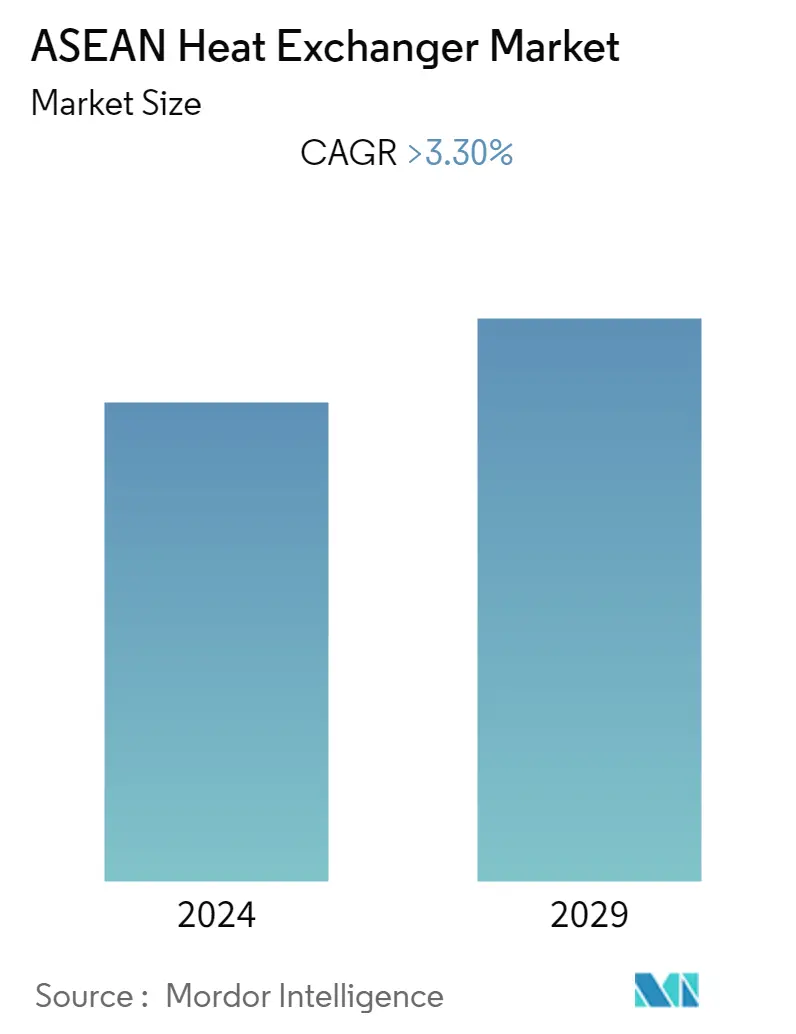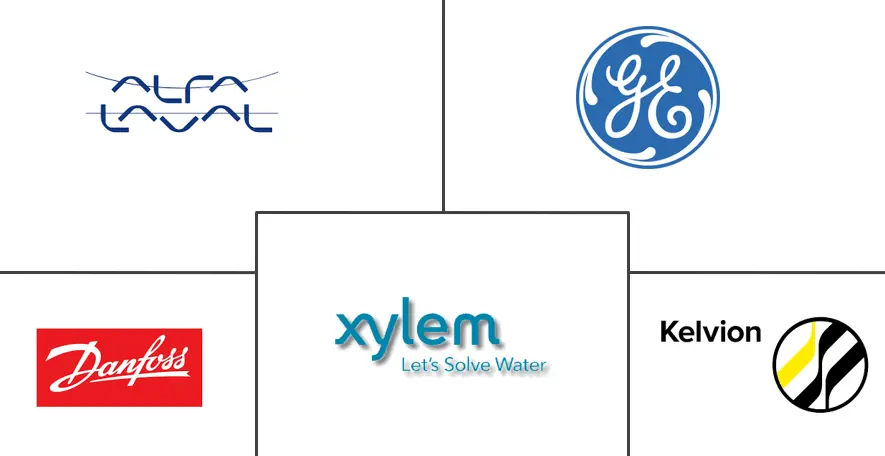Market Size of ASEAN Heat Exchanger Industry

| Study Period | 2020 - 2029 |
| Base Year For Estimation | 2023 |
| Forecast Data Period | 2024 - 2029 |
| Historical Data Period | 2020 - 2022 |
| CAGR | > 3.30 % |
| Market Concentration | Low |
Major Players
*Disclaimer: Major Players sorted in no particular order |
ASEAN Heat Exchanger Market Analysis
The ASEAN heat exchanger market is expected to register a CAGR of greater than 3.3% during the forecast period of 2021 - 2026. The COVID-19 pandemic has already cast its shadow on various industries, with the heat exchanger market being no exception. One important aspect of the industry that has been impacted was maintenance. With strict orders on social distancing and lockdowns in place throughout the ASEAN countries, many steam and boiler maintenance businesses, including heat exchangers, have been unable to provide services such as routine inspections and maintenance as regularly as they once did. Factors such as increasing industrialization in emerging ASEAN countries, low maintenance cost, and soaring demand for space heating and cooling applications are expected to drive the heat exchanger market in ASEAN region during the forecast period. However, an increase in renewable energy, which rarely requires a heat exchanger, is expected to have a negative impact on the market studied.
- Shell and Tube heat exchangers are expected to witness significant growth during the forecast period, owing to the multiple associated benefits when compared to other construction types. They are most commonly used heat exchangers for industrial applications.
- Technological advancements and upgradations are likely to create immense opportunities for the heat exchanger market in ASEAN region soon.
- Indonesia is expected to witness significant demand during the forecast period, owing to the plans of increasing power generation capacity in the coming years.
ASEAN Heat Exchanger Industry Segmentation
The ASEAN heat exchanger market report includes:
| Construction Type | |
| Shell and Tube | |
| Plate and Frame | |
| Other Construction Types |
| End-User | |
| Oil and Gas | |
| Power Generation | |
| Chemical | |
| Others End-Users |
| Geography | |
| Singapore | |
| Malaysia | |
| Thailand | |
| Indonesia | |
| Rest of ASEAN Countries |
ASEAN Heat Exchanger Market Size Summary
The ASEAN heat exchanger market is poised for growth, driven by increasing industrialization and the demand for space heating and cooling applications in emerging countries within the region. Despite the challenges posed by the COVID-19 pandemic, which affected maintenance services due to social distancing and lockdown measures, the market is expected to benefit from the low maintenance costs and the rising need for efficient heat transfer solutions. The market is characterized by a diverse range of applications, with shell and tube heat exchangers anticipated to experience significant growth due to their advantages in industrial settings, such as oil refineries and large-scale pharmaceutical and chemical industries. These heat exchangers are favored for their ability to operate under high temperatures and pressures, low servicing requirements, and cost-effective manufacturing, making them ideal for various applications requiring robust and flexible solutions.
Indonesia is expected to be a key player in the ASEAN heat exchanger market, driven by its plans to increase power generation capacity and the ongoing expansion of coal-fired and natural gas power plants. The country's energy landscape, dominated by coal and natural gas, presents a favorable scenario for heat exchangers, which are essential for thermal power generation. The shift towards cleaner energy and the growth in natural gas production further bolster the market's prospects. Additionally, innovative projects, such as utilizing geothermal energy for industrial processes, are expected to create new opportunities in the market. The fragmented nature of the market sees major players like Alfa Laval AB, General Electric Company, and Danfoss AB actively participating, with ongoing projects and replacements in countries like Indonesia and Malaysia highlighting the dynamic nature of the industry.
ASEAN Heat Exchanger Market Size - Table of Contents
-
1. MARKET OVERVIEW
-
1.1 Introduction
-
1.2 Market Size and Demand Forecast in USD million, till 2026
-
1.3 Recent Trends and Developments
-
1.4 Government Policies and Regulations
-
1.5 Market Dynamics
-
1.5.1 Drivers
-
1.5.2 Restraints
-
-
1.6 Supply Chain Analysis
-
1.7 Porter's Five Forces Analysis
-
1.7.1 Bargaining Power of Suppliers
-
1.7.2 Bargaining Power of Consumers
-
1.7.3 Threat of New Entrants
-
1.7.4 Threat of Substitutes Products and Services
-
1.7.5 Intensity of Competitive Rivalry
-
-
1.8 Assessment of COVID-19 Impact on the Industry
-
-
2. MARKET SEGMENTATION
-
2.1 Construction Type
-
2.1.1 Shell and Tube
-
2.1.2 Plate and Frame
-
2.1.3 Other Construction Types
-
-
2.2 End-User
-
2.2.1 Oil and Gas
-
2.2.2 Power Generation
-
2.2.3 Chemical
-
2.2.4 Others End-Users
-
-
2.3 Geography
-
2.3.1 Singapore
-
2.3.2 Malaysia
-
2.3.3 Thailand
-
2.3.4 Indonesia
-
2.3.5 Rest of ASEAN Countries
-
-
ASEAN Heat Exchanger Market Size FAQs
What is the current ASEAN Heat Exchanger Market size?
The ASEAN Heat Exchanger Market is projected to register a CAGR of greater than 3.30% during the forecast period (2024-2029)
Who are the key players in ASEAN Heat Exchanger Market?
Alfa Laval AB, General Electric Company, Danfoss AB, Xylem Inc. and Kelvion Holding GmbH are the major companies operating in the ASEAN Heat Exchanger Market.

